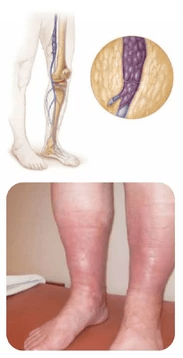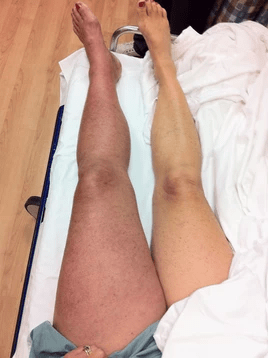Blood returns to the heart through veins. When the blood clumps together and turns into solid material, it is called a blood clot. When the clot is in the deep vein it is called deep vein thrombosis (DVT). Deep vein thrombosis (DVT) usually occurs in the leg veins.
If the clot breaks off and travels to the lungs, it can cause a pulmonary embolism (PE) – a clot that blocks blood flow to the lungs, which can be deadly.
DVT causes symptoms in only about half the people who develop this condition. Symptoms may include:
- Swelling of the leg
- Pain or tenderness in the leg
- Increased warmth in the swollen or painful area
- Red or discolored skin in the swollen or painful area of the leg


Some people may not know they have a DVT until it breaks off and travels to the lungs, causing a pulmonary embolism. PE is an emergency situation requiring immediate medical help.
PE symptoms include:
- Sharp chest pain when taking a deep breath
- Shortness of breath
- Bloody cough
- A rapid or irregular heartbeat
- Feeling of anxiety
- Feeling faint or passing out

DVT causes symptoms in only about half the people who develop this condition
Causes
Blood normally flows continuously in arteries and veins. In certain situations the cells in blood may clump together to form a plug (blood clot) and fail to flow properly. This is triggered whenever flowing blood is exposed to certain substances after the vein’s inner lining is damaged as a result of surgery, serious injuries, inflammation or immune responses.
Inactivity is a major cause of DVTs. Extended periods of lying down can lead to sluggish, improper flow of blood in your legs. Some of the leading causes of DVT are surgery, injuries or illnesses requiring prolonged period of bedrest.
Other possible causes include cancer, hormone therapy and inherited conditions that make blood cells clump together and form clot more easily. Birth control pills can also increase the risk of clotting.
Risk Factors
- A previous episode of DVT
- Immobility, such bed rest during hospitalization
- Pregnancy and the first few weeks after giving birth
- A catheter (large IV tube) in the deep veins used for medical treatment
- Age – DVT can occur at any age, but risk increases with age
- Overweight or obesity
- Cancer and cancer treatment
- Smoking
- Hormone therapy or birth control pills
- Injury to blood vessels, broken bones or other trauma
- Some inherited blood disorders
Evaluation
To determine if DVT is present, your doctor will obtain your medical history and perform an examination. Your diagnostic tests may include:
Duplex ultrasound: Noninvasive test uses high-frequency sound waves to measure blood flows through your veins and evaluate the presence of clot.
D-dimer test: Measures a substance in the blood that when elevated may indicate underlying blood clot.
CT Venogram: Imaging test that uses IV contrast and specialized CT scan to create detailed pictures of the veins in your abdomen and legs.
Venography: Dye is injected into a vein in the affected leg. The dye makes the vein visible on an x-ray image. The x-ray shows whether blood flow is slow in the vein, which may suggest a blood clot.
Complications
Pulmonary embolism (PE): Most of the time with a DVT the clot is in the veins of the lower or upper extremities and attached to the vein wall. When the clot dislodges from the vein it will travel to another part of the body, this is called an embolus. With PE, the clot travels to the lungs and blocks blood flow. As a result, the lungs can be damaged by lack of blood flow, and other organs can be damaged by a lack of oxygen supplied by the lungs. PE is a dangerous, potentially fatal occurrence requiring immediate medical attention.
Post-thrombotic syndrome (PTS): Is a condition that may develop one to two years following an episode of DVT. Following a DVT the veins involved may be damaged and there be underlying blockage or reversal of blood flow. Both of these situations can lead to increased venous blood pressure in the legs. The symptoms associated with this condition, known as PTS, may include chronic leg pain and chronic swelling. Advanced stages of the condition include skin damage with discoloration and/or ulceration (wound) in the affected leg.
For Deep Vein Thrombosis treatment options and prevention visit our page:
https://www.advancedheartandvein.com/deep-vein-thrombosis
